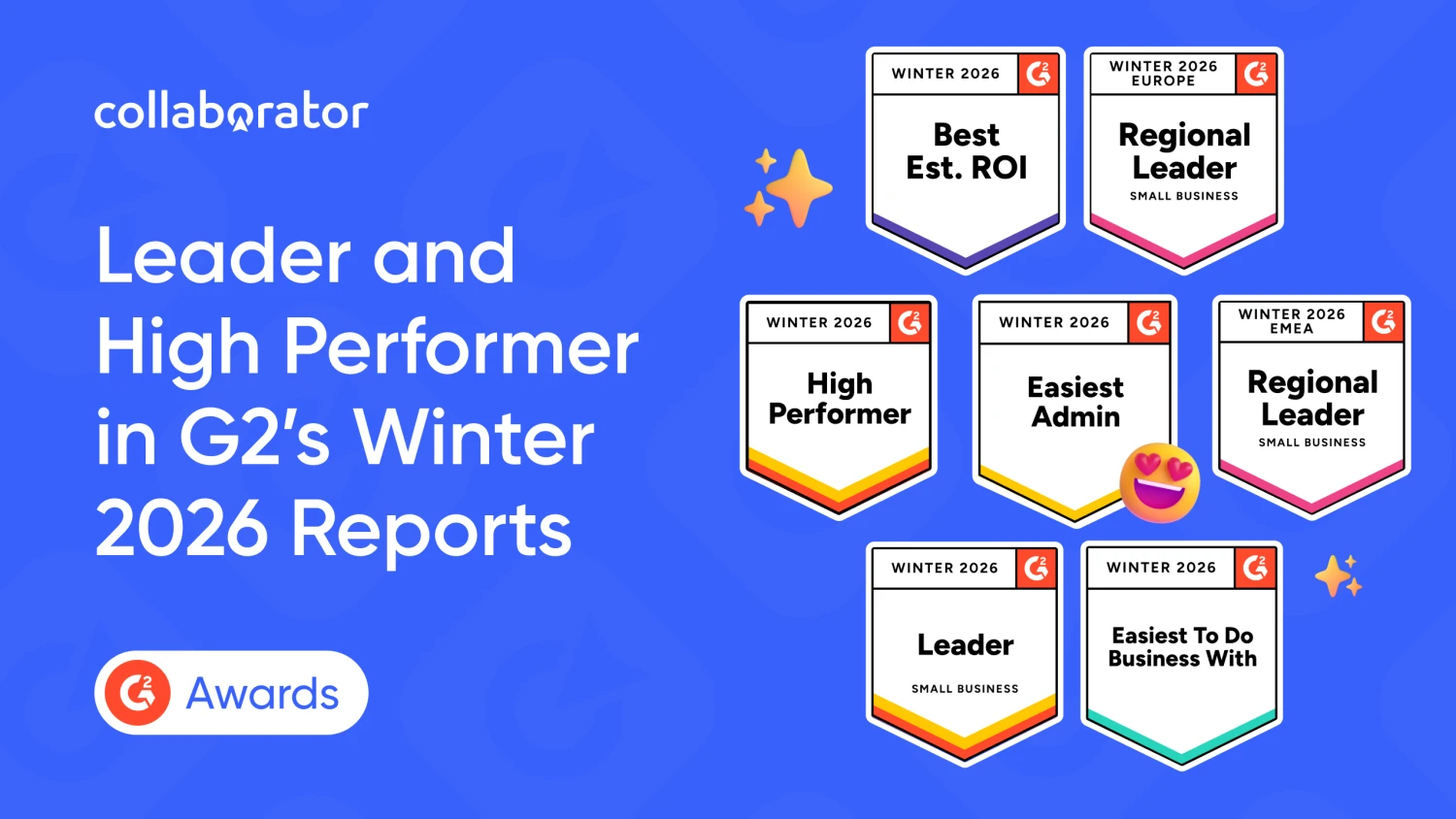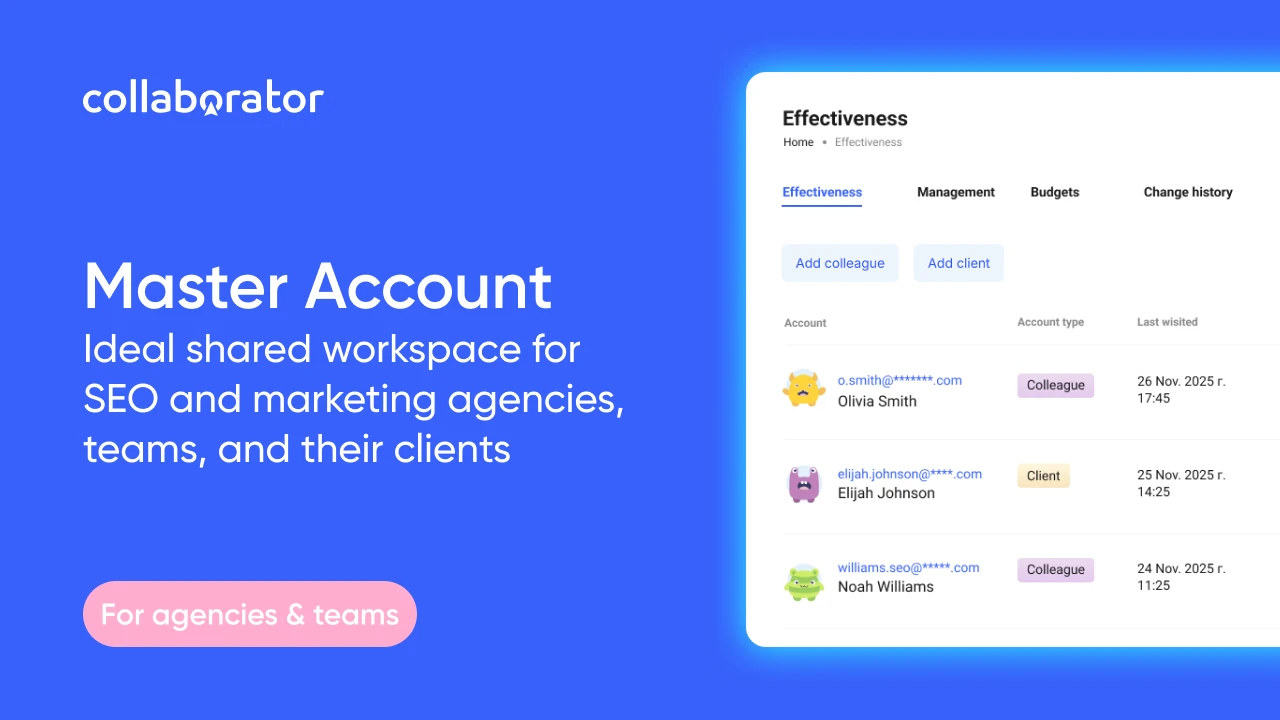
If you're just starting to promote your website and are new to SEO, you may wonder what a backlink profile is and why it seems so important. We're guessing you've been reading tons of new information recently, and learning all these new terms can become overwhelming.
We have structured the essential knowledge necessary for analyzing and improving your backlink profile, avoiding all unnecessary details. Today, we will tell you what it is, how it works, why it is important, and how to improve it. We will also demonstrate how to use some of the top SEO tools on the market.
So, let's review what we know and start with the basics.
What's a Backlink Profile?
A backlink profile is a collection of all links that refer people to your website. Generally speaking, a backlink is a link from one website to another. If you're the one who has a website and puts a link to any other platform on it — you are acting as a link acceptor. If it's the opposite way, and the other website has the link to your website, they are a link donor, meaning they provide a backlink.
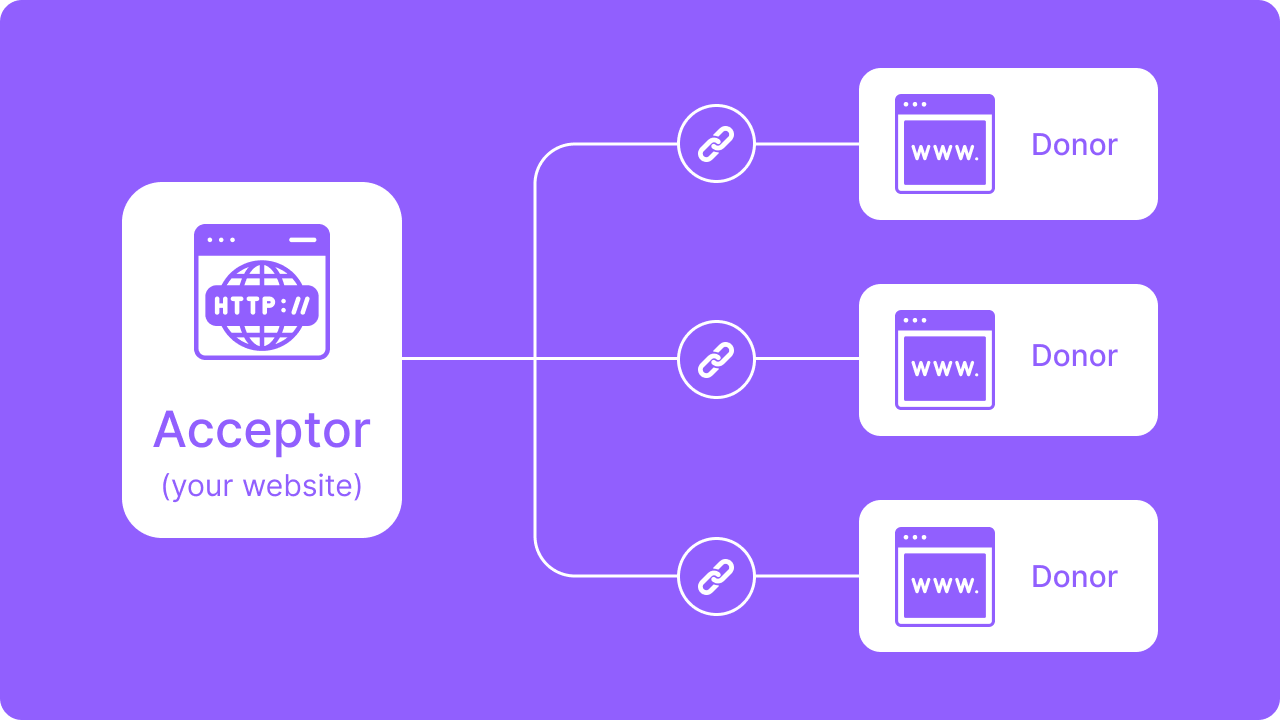 A visual explanation of being a link donor vs. link acceptor
A visual explanation of being a link donor vs. link acceptor
Now, let's take a look at what a link profile consists of.
- A number of backlinks.
A total of all the links pointing to your website. - Link quality.
A high-quality link is relevant and trustworthy, which can be judged by various metrics. Let's examine the main differences between a strong vs. a bad backlink. If you want to learn more about it, read our article about the red flags of bad backlinks.Good Backlink
Bad Backlink
A link from a high-authority, quality website with high organic traffic. A link from an irrelevant, low-quality, or low-traffic website. Relevant and diverse anchor texts. Over-optimized, unnatural use of keywords in anchor texts. Contextual links with an in-content placement. Non-contextual placements (footers, sidebars, etc). Backlinks received through white hat SEO (manual outreach, guest posting, partnerships etc). Backlinks bought in bulk from unverified sources. - Link diversity.
Just having a lot of links is not enough — they should also be balanced in terms of the sources. Apart from being of high quality, your backlink profile must also be diverse. - Anchor text.
The anchor texts you use should be concise and relevant to your niche. Anchor texts improve the user experience and play a crucial role in indexing your website. - Backlink source.
You know the saying that goes, "Tell me who your friends are, and I will tell you who you are"? The same principle applies to your backlink donors — they tell Google a lot about your website. - Link mass dynamic.
Search engines care not only about where you get your backlinks from but also about how often you do it. If you're seeing more lost links than new ones, it might be a warning signal.
Why Is a Strong Link Profile Important?
A strong backlink profile is crucial to your website optimization. Like with any aspect of SEO, one of the main goals of link building is to help the search engine crawler understand what your website is about and show it to your target audience.
Now that we know what it is and why it is important, you probably wonder how it works. It gives the crawler more information, but why should you care about it? Let's explore why you should strengthen your backlink profile.
3 Reasons to Improve Your Backlink Profile
- Improve SERP rankings.
When your website continuously receives quality backlinks from trusted, established sources, search engines start to treat your website accordingly. By improving your backlink profile, you will also improve your chances to rank higher in search engine result pages. - Increase your organic traffic.
You will receive more traffic not only from ranking higher but also directly from your link donors. Win-win! - Build your credibility.
We've already mentioned how getting backlinks from trusted sources leads search engines to trust your website more. In addition, you'll build credibility among your target audience — an established industry expert would not quote someone untrusted.
Now that we've covered the basics let's dive into what makes a good link profile and how to improve it.
A good backlink profile consists of high-quality natural backlinks that improve your website's visibility. As we've learned, having a strong backlink profile also helps you to improve search engine rankings, drive organic traffic, and establish credibility in your niche.
How to Measure Backlink Profiles
First of all, you have to know what to look for. Here is a small step-by-step guide on what metrics you should check when doing a backlink profile analysis:
- Upon logging into any backlink checker, you'll see an overview of the dashboard. Take a look at the key metrics. You may want to check the total number of backlinks and referring domains, their dynamic, and their authority ranking.
- Take a look at the most popular anchor texts. Are they relevant? Do you have anchor text diversity? Are there any spammy ones?
- Analyze referring domains — is there a good balance? Are there any unique domains? What is their domain authority rate?
- Reflect and analyze your link building strategy. What's working best? Is there a balance in the types of links you're getting? Are there any spammy links?
Now that you know the metrics for conducting your backlink profile audit, let's explore which tools you can use. We've created a list of the best SEO tools for free backlink analysis.
TOP 5 Backlink Analysis Tools
There are many backlink checkers out there, and at first glance, they might all seem the same, making it hard to choose. That's why we've collected a list of the top free SEO tools to measure backlink profile quality. If you need the tools for any other SEO tasks, you can check out our list of top 60 SEO tools.
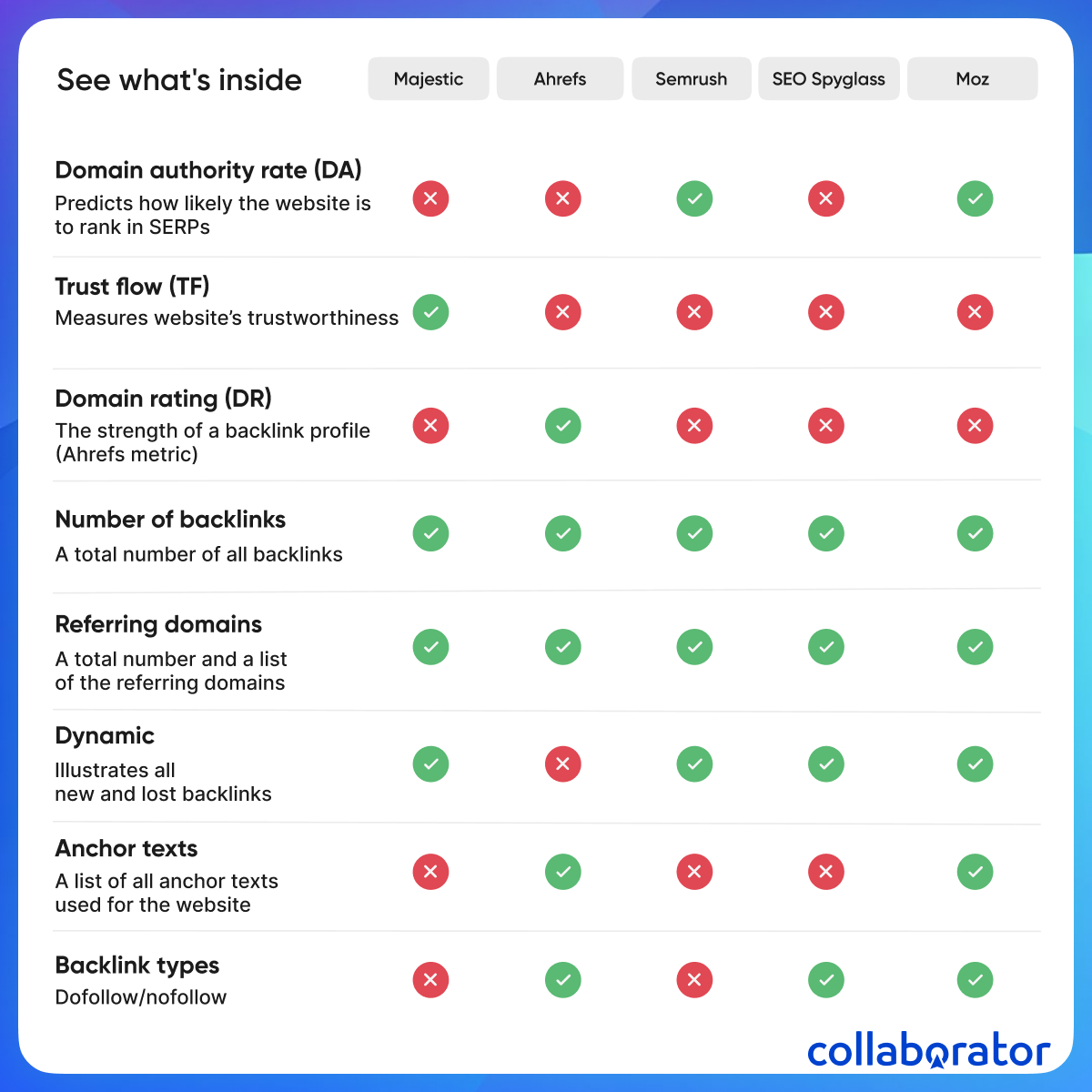 A comparison guide to the top 5 free backlink checkers
A comparison guide to the top 5 free backlink checkers
For better clarity, we analyze a backlink profile of a well-known website, Buzzfeed, using each tool to demonstrate what it looks like and which metrics you can get from their free version.
Pro Tip: Note how the data differs from tool to tool — it’s always better to cross-check your website with different services to get a clearer picture.
1. Majestic
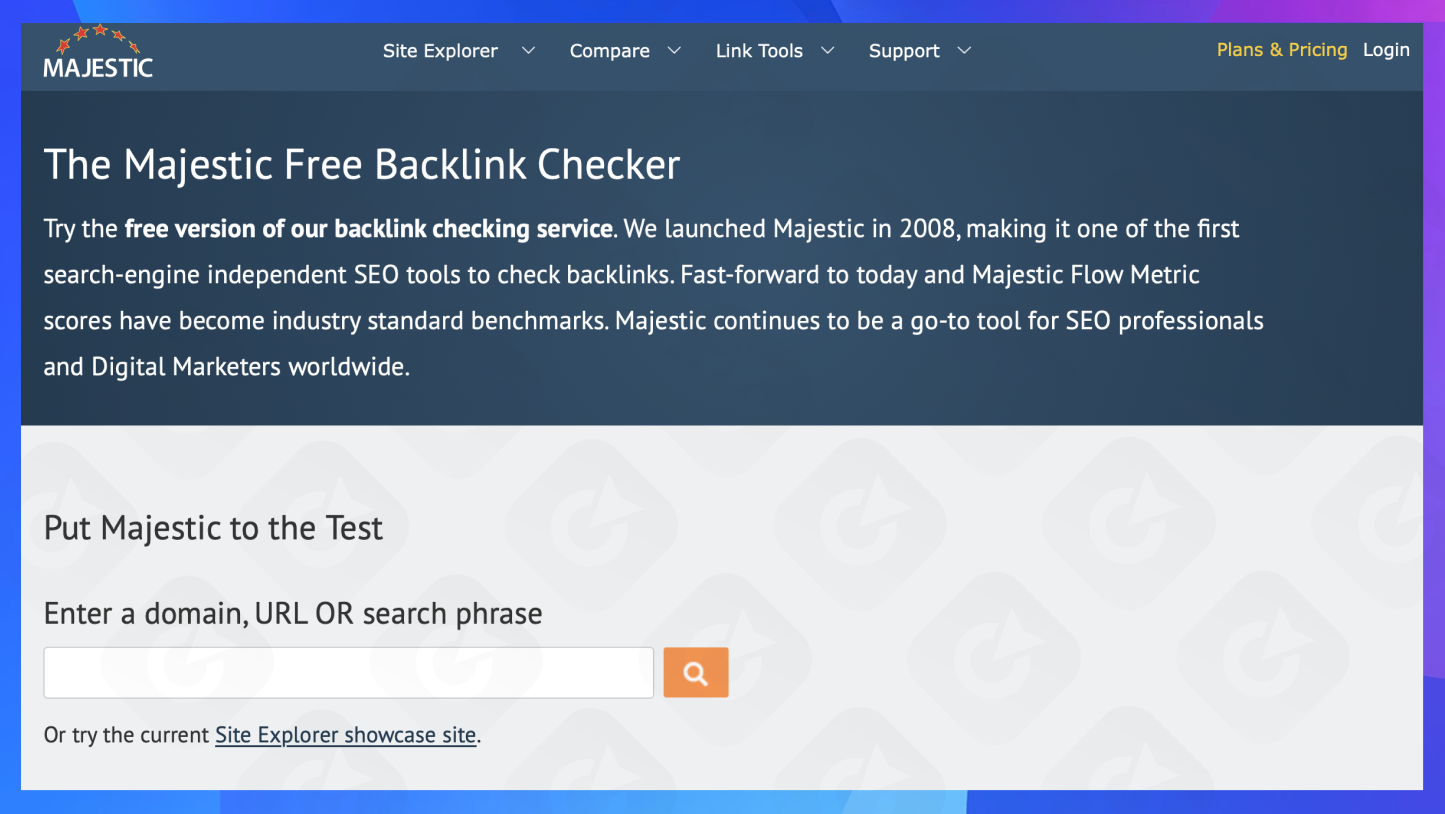 The Majestic Free Backlink Checker home page
The Majestic Free Backlink Checker home page
Majestic is one of the most popular SEO tools, known for its fresh and accurate data. However, its free backlink profile tool is not very informative.
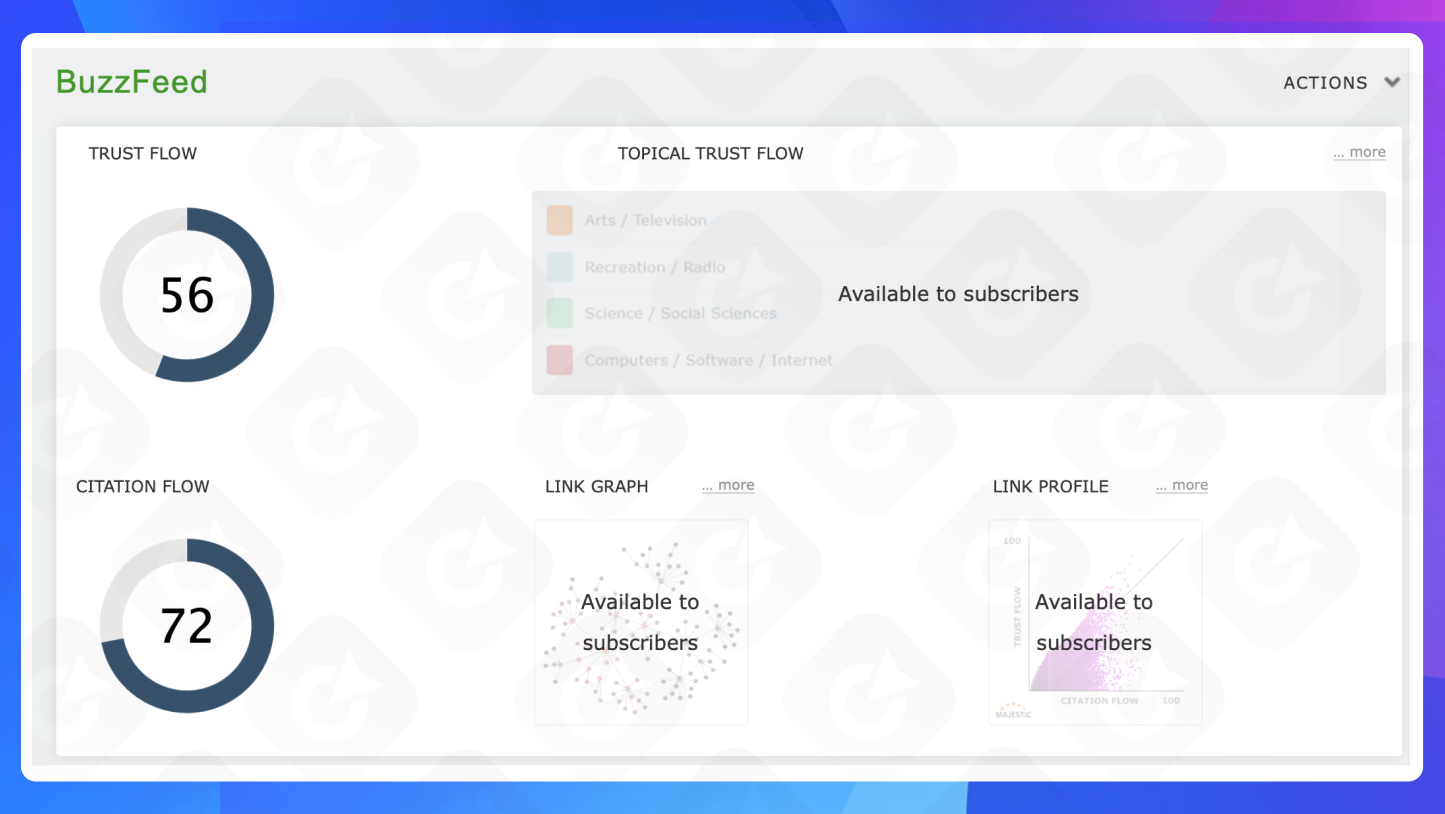
Majestic backlink checker only gives the key metrics for free: trust flow & citation flow
It does provide the trust flow score (its own feature!) and citation flow, but all the other metrics are paywalled. It's a good place to start, but it will give you much more detailed data with their paid version (starting at $49.99 monthly).
2. Ahrefs
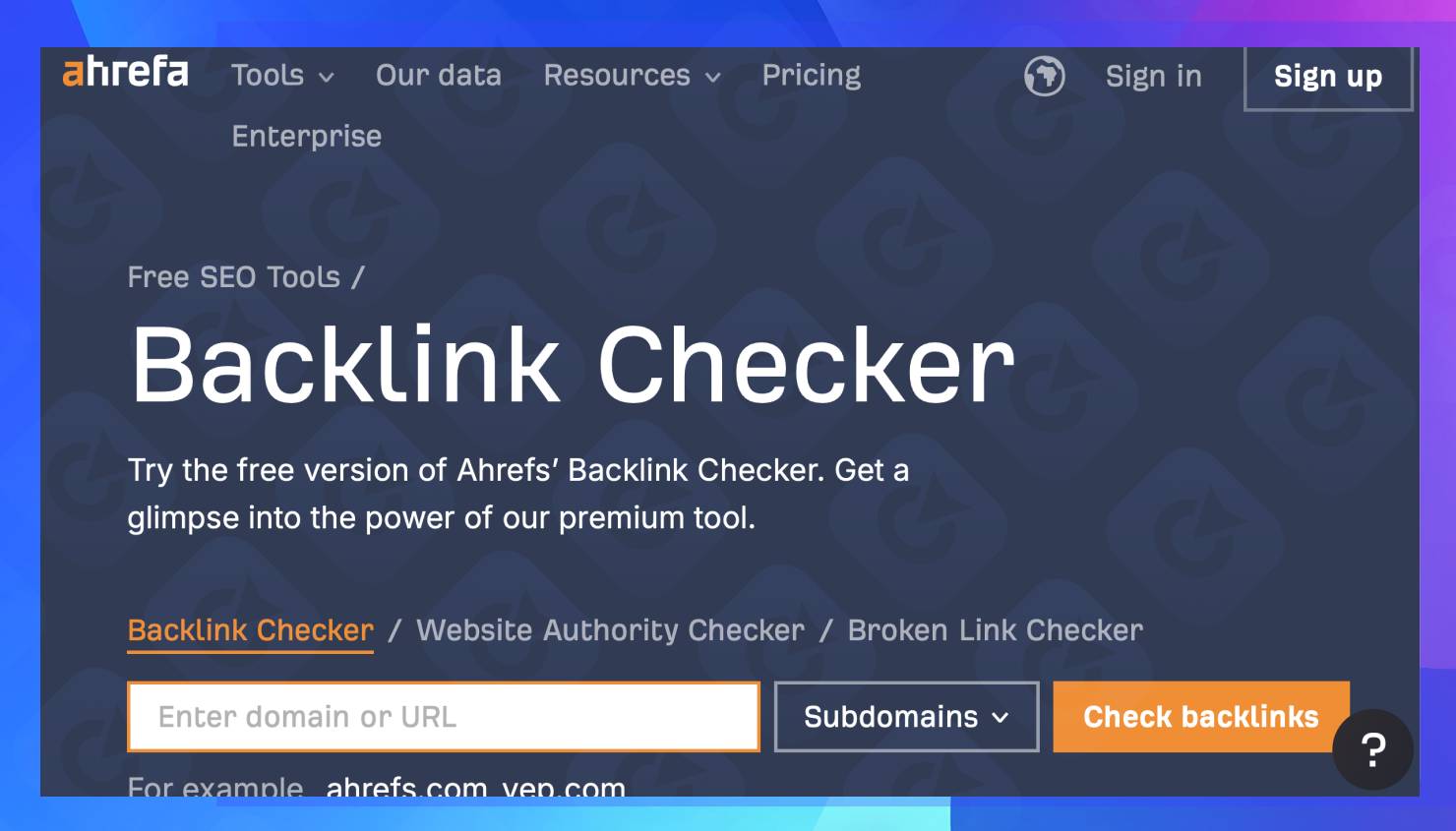
Ahrefs Backlink Checker homepage — you’ll find it directly under the “Tools” section
Even if you’re new to SEO, most likely you’ve already heard about Ahrefs. It is one of the most popular SEO tools out there, and despite being a paid service, it provides some features for free.
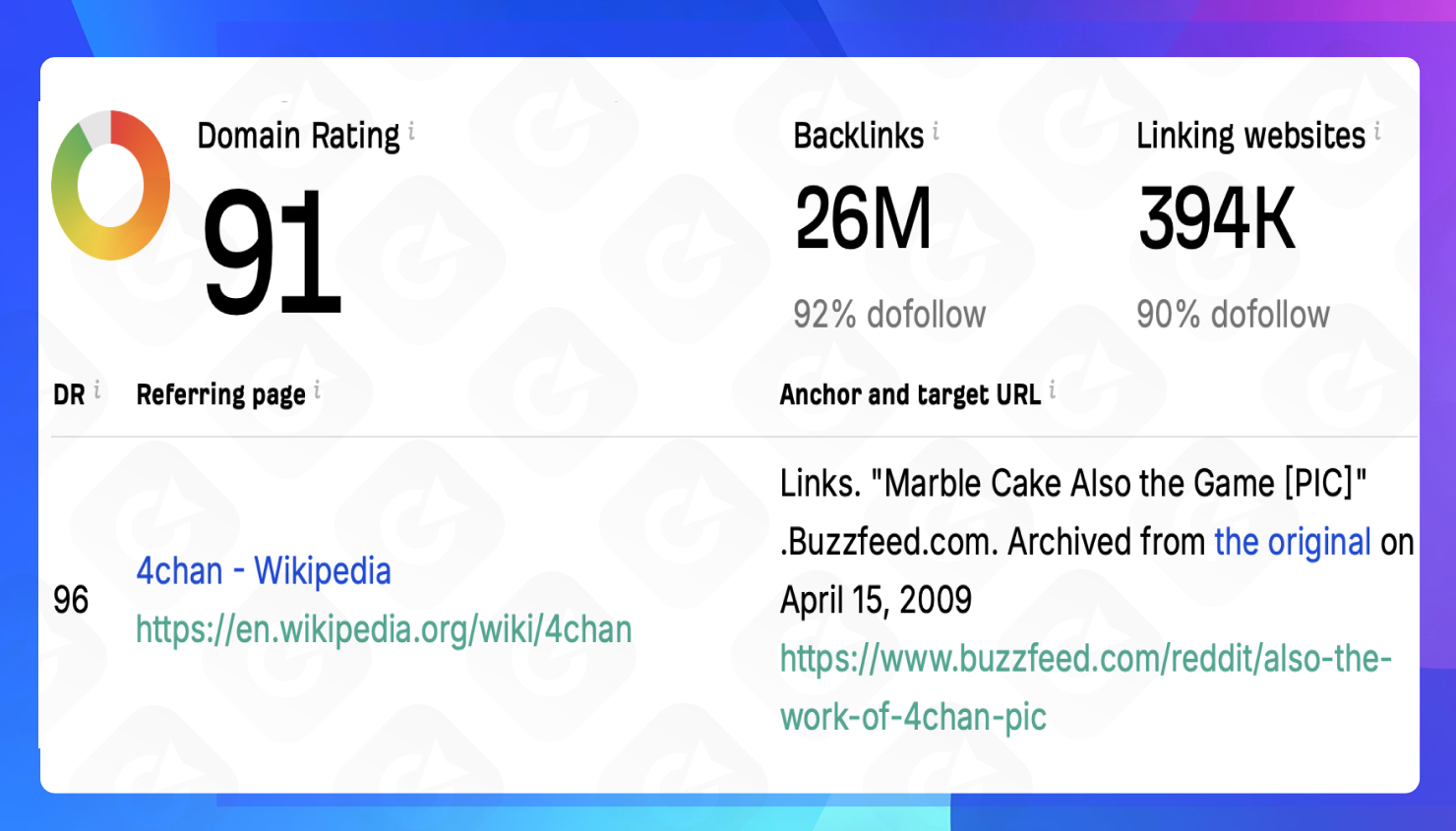
Ahrefs backlink checker covers the bare basics
In a free version of the Ahrefs Backlink Checker, you can see some of the most important metrics for backlink profile analysis: the total number of backlinks and linking websites — both are sorted by their type, the top referring pages and their anchor texts, and domain rating (its own metric). If you sign up (their prices start at $99/monthly and go up to $399/monthly), you can see much more detailed information.
3. SEO SpyGlass
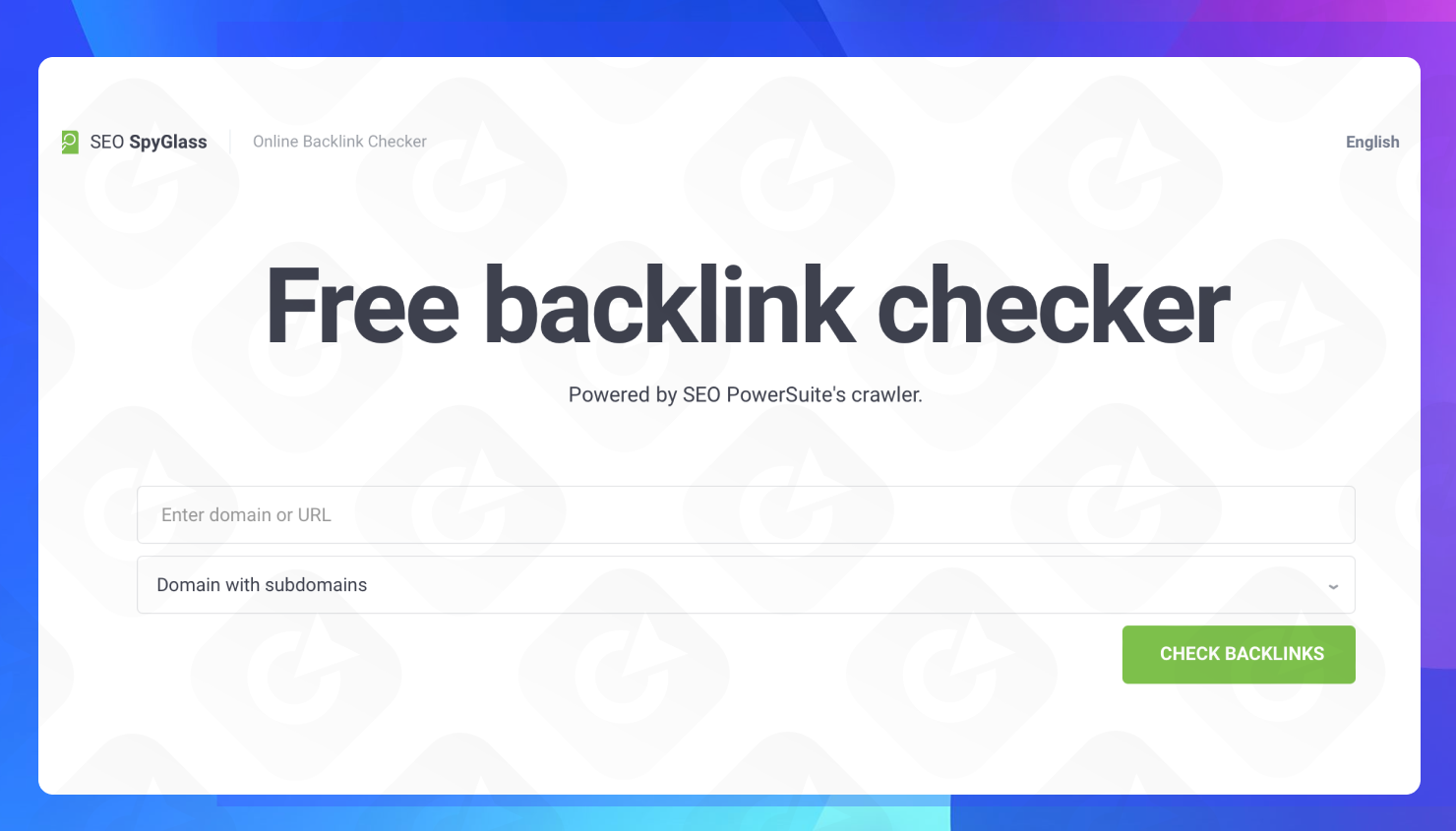 A welcome page of SEO SpyGlass free backlink checker
A welcome page of SEO SpyGlass free backlink checker
SEO SpyGlass is a backlink checker from SEO PowerSuite. One of its best features is the ability to integrate Google Search Console and Google Analytics, which ensures the highest accuracy.
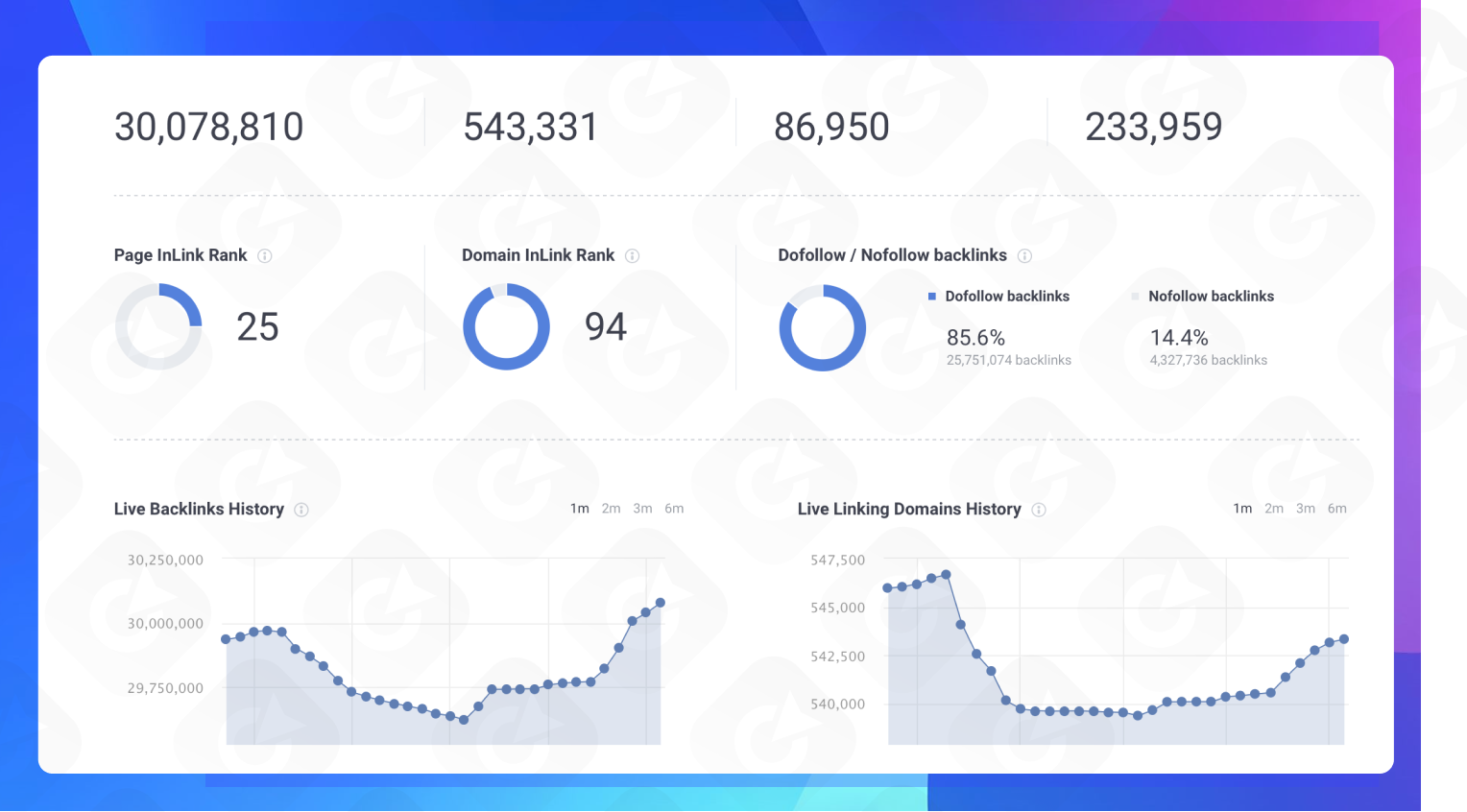
A quick glance into the SEO SpyGlass dashboard
The only downside to it is that it requires sign-up (which is free!). They also have a desktop version that you can download, but an online version will do if you're only using it as a backlink checker.
4. MOZ Link Explorer
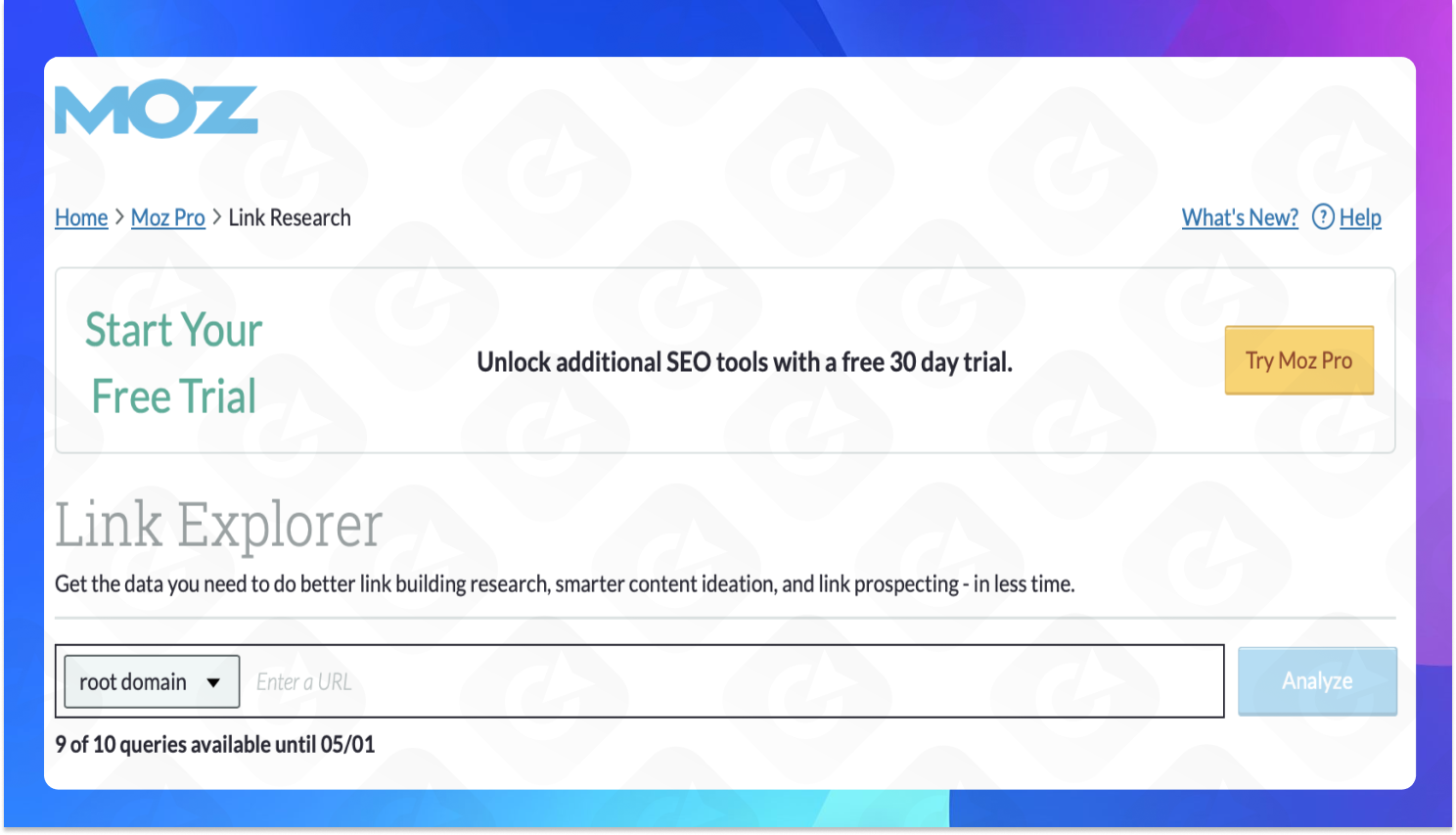
Moz Link Explorer main page — you can find it in the “Link Research” section
Moz is a powerful all-in-one tool that requires registration to use its free features, which include Rank Tracker, Keyword Explorer, and Link Explorer. Moz is popular due to its accuracy, and it provides a lot of data, even in a free version.
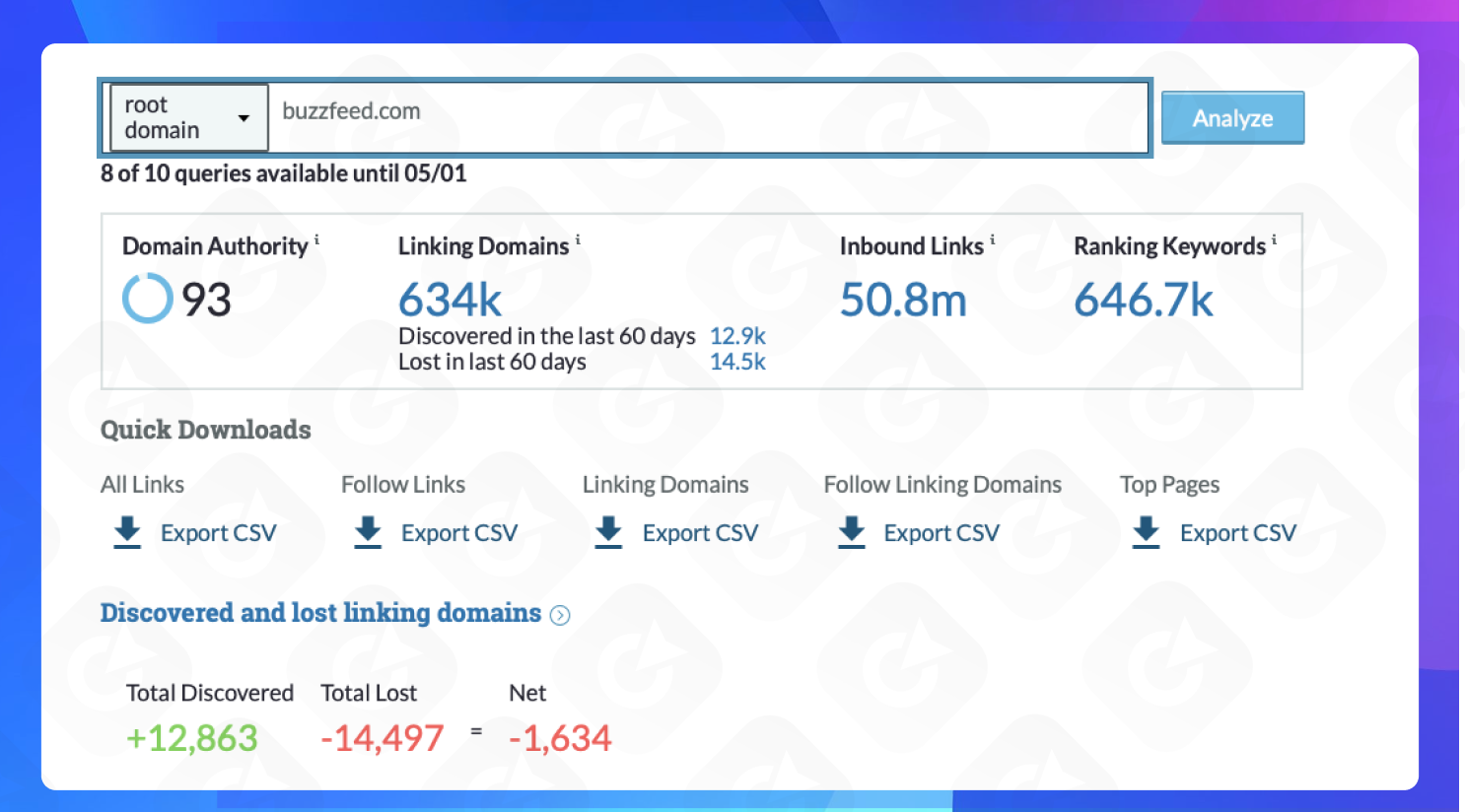
This is what a Moz Link Research dashboard looks like from the inside
The free version includes all the basics, so Moz would be an excellent tool to start with if you don't want to get too deep.
Now that you know how to analyze backlink profiles, you may want to improve yours. Below are some tips and tricks to improve your backlink profile. We've included a convenient checklist so you can save it and use it for reference!
How to Build a Strong Backlink Profile
Understanding the importance of link building for SEO is crucial to succeed in the changing online world. Here is a small checklist that will help you get started!
- Quality over quantity.
If your website is getting quality backlinks from trustworthy websites, it helps you much better than just having a bunch of links from multiple shady websites. So you have to be careful — if you get a lot of bad backlinks from untrusted sources, Google can consider it to be black hat SEO. It will strongly penalize your website if you go against Google's Webmaster Guidelines, and most search engines will do the same.
- Relevancy.
The same principle applies: having your website credited by only 2-3 quality sources is better than having a lot of bad backlinks. Most of them should be relevant to your niche, but some can be from other platforms — having a news platform doesn't make it relevant, but it's still a good backlink to have in your profile.
- Diversity.
Your backlink portfolio should include a variety of sources — websites, forums, social media, blogs, you name it. It should also be diverse in terms of anchor text — it would have branded anchor text, image anchor text, naked URLs, and so on. It will also have different link types, such as dofollow vs. nofollow.
- Internal linking.
Creating internal linking is one of the easiest but still crucial SEO strategies. Internal links are essential in SEO because they help Google correctly index all your web pages. All you need to do is cross-link your own website pages by anchoring the relevant keywords in your articles to one another. Make sure you've completed this step before you're diving into external link building!
- Conduct competitor analysis.
First things first, you need to know what your competitors are doing. A thorough analysis will help you determine the best link-building strategies and what's working and not specifically for your niche.
- Create high-quality content.
As Bill Gates once said, content is king. This statement is especially true when it comes to SEO: having quality content will help you organically grow your website traffic by having more platforms naturally refer to you.
- Visual content (anchor images).
To piggyback on the previous point, a good backlink–building strategy would be to create high-quality, original visual content — infographics, images, even memes — that other web pages would naturally add to their websites. If your website is getting links from the visuals you use, it might be a good idea to invest more time in them.
- Outreach.
Outreach in SEO is when you reach out to other platforms and get backlinks from collaborations, partnerships, influencer marketing, and so on.
- Forums & social media.
This one kind of speaks for itself. With this one, you have to be careful: too many forum backlinks can be considered "spammy" by Google, so you have to find the balance. You can check out our Telegram channel collection to try it out and start from there!
- SEO agencies.
If you don't want to do it yourself (no judgment, we know you have a lot on your shoulders already), or trying to do more local SEO, you can always outreach link building to professionals. There are a lot of qualified link builders that will also be able to conduct your backlink profile audit more professionally – they do it for a living. Make sure to choose only the best SEO companies.
- Guest posting.
Last but not least! If you're still new and struggling to get free backlinks or don't know where to find them, you can engage in something called "guest posting." Guest posting is the practice of having your article posted on another website in order to receive a backlink. One good way to start doing that would be checking out our site catalog — so far, we've collected over 30K credible and trustworthy website donors from all around the world for you to choose from!

In Collaborator's catalog, you can select all the metrics you need to analyze your potential website donor, including integrated options from Ahrefs.
Collaborator's catalog features trustworthy websites from all over the world. Thanks to Ahrefs integration, you can view their key metrics in one click and filter them by traffic, region, subject, keywords, and much more.
Conclusion
To summarize everything we've covered today, having a strong backlink profile is crucial to SEO. It enables you to continually grow your traffic and rank higher in search engine result pages, leading to increased conversions. By utilizing various SEO tools, such as backlink checkers, you can analyze your backlink profile and identify areas that need improvement.
No matter what niche your business is in, if you're looking to promote your website online, implementing link-building strategies such as outreach and guest posting would be an excellent way to start. And Collaborator can help you out with that. Check out our catalog to buy backlinks and start improving your backlink profile today.
Now, you're all set to start promoting your website online! Good luck to you in your future SEO endeavors🙂
Related reading
- • 12 SEO Experts Reveal 10 Link Building Strategies to Skyrocket Your Rankings in 2025
- • Collaborator Unveils Racoon SEO Link Checker: The Free Chrome Extension You Need for Better SEO
- • How to Get High Quality Backlinks to Promote Your Site
- • 6 Best Free Backlink Monitoring Tools to Track Link Building Success in 2025


